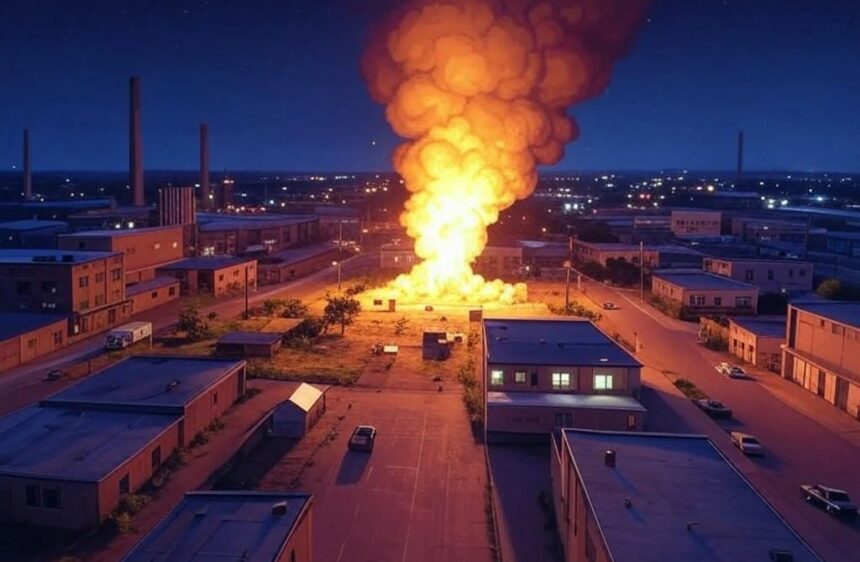On July 2, 1993, an industrial explosion rocked Baytown, Texas, registering a 4.3 magnitude on the Baytown Explosion 1993 4.3 Rictor Scale. The explosion occurred at the ARCO Chemical Company plant, a facility engaged in petrochemical production. This disaster resulted in significant structural damage, environmental hazards, and regulatory changes in the industry.
The explosion raised serious concerns about industrial safety and emergency preparedness. It also highlighted the risks associated with petrochemical plants, which store and process highly volatile substances. The event led to investigations, regulatory reforms, and changes in safety procedures to prevent similar incidents in the future.
This article provides a thorough analysis of the explosion, including its causes, impact, and the lessons learned from this catastrophic event.
Overview of Baytown, Texas
Baytown, Texas, is a key location for the petrochemical industry, housing major refineries and chemical plants. The city’s economy largely depends on these industrial operations, making safety measures crucial.
Due to its proximity to the Gulf of Mexico, Baytown has been a strategic location for industrial activities for decades. The presence of multiple industrial facilities increases the risk of accidents, making incidents like the 1993 explosion particularly concerning for both workers and nearby residents.
Details of the Explosion
Date, Time, and Location
- Date: July 2, 1993
- Time: Around 1:00 PM
- Location: ARCO Chemical Company Plant, Baytown, Texas
The explosion happened during working hours, increasing the potential risk for injuries. Workers inside the facility were immediately affected, while residents in surrounding areas felt the impact of the shockwave.
Magnitude of the Explosion
The explosion was so powerful that it registered a 4.3 magnitude on the Richter scale. While typically used to measure earthquakes, this scale also helps quantify the energy released in large-scale industrial explosions. The blast was felt miles away, causing widespread panic among residents and workers.
Initial Reports
The initial reports from emergency responders and witnesses described a loud explosion followed by a massive fireball. People in nearby areas mistook the explosion for an earthquake. Authorities immediately responded to assess the situation and contain the fire. Firefighters and hazardous material teams worked tirelessly to prevent further chemical leaks and limit the environmental damage.
Causes of the Explosion
Equipment Failure
Investigations revealed that a malfunctioning process vessel led to the uncontrolled release of volatile chemicals, triggering the explosion. The failure of this critical equipment indicated serious operational flaws in the facility. If the equipment had been properly maintained and monitored, the explosion might have been prevented.
Maintenance Issues
Routine maintenance was not conducted as per required safety protocols. Unchecked equipment deterioration contributed to the malfunction, showing the importance of regular inspections in industrial settings. Reports indicated that some safety procedures had been ignored, allowing hazardous conditions to develop over time.
Human Error
Human errors also played a role in the explosion. Workers failed to identify warning signs before the incident. In some cases, critical safety protocols were not followed, increasing the risk of hazardous reactions. The lack of proper monitoring systems further delayed the identification of potential risks, making the explosion more likely.
Chemical Reactions
The presence of highly flammable chemicals in the plant worsened the explosion. The chemicals released toxic fumes into the air, raising environmental and health concerns. The explosion’s heat caused additional chemical reactions, spreading the fire and making it more difficult for emergency responders to control the situation.
Immediate Consequences
Structural Damage
The explosion caused severe structural damage within and outside the plant. The force of the blast destroyed key production areas, damaged nearby buildings, and shattered windows in residential and commercial areas.
Local businesses and homes sustained minor damage due to the powerful shockwave. Some buildings required significant repairs, while others were temporarily closed due to safety concerns.
Human Impact
Workers inside the plant suffered injuries due to the explosion and subsequent fires. Many of them required medical attention for burns and inhalation of toxic fumes. Nearby residents also reported breathing difficulties due to the release of hazardous chemicals.
Evacuations were carried out to protect those living close to the site. Emergency medical teams provided immediate treatment, and some individuals were transported to hospitals for further care.
Environmental Impact
The explosion released hazardous chemicals into the air and water, leading to serious environmental concerns. Toxic fumes spread through the atmosphere, affecting air quality. Water contamination occurred due to firefighting efforts, as runoff carried chemicals into local waterways.
Long-term ecological damage became a major concern. Environmental agencies conducted assessments to determine the extent of the pollution and implemented measures to reduce its impact. The explosion served as a reminder of the environmental risks associated with industrial operations.
Emergency Response Efforts
Evacuation and Rescue Operations
Authorities quickly implemented evacuation procedures to prevent additional casualties. Workers and nearby residents were relocated to safe zones. Firefighters and hazardous materials teams worked to contain the flames and prevent secondary explosions.
Rescue teams searched for injured individuals and provided medical aid. Their efforts were crucial in minimizing the human toll of the disaster.
Challenges Faced by Responders
Emergency responders faced several challenges in handling the situation. The intense heat and chemical exposure made firefighting efforts dangerous. Limited access to key areas due to structural damage also complicated rescue operations.
Communication breakdowns delayed some response efforts, highlighting the need for better emergency coordination. Despite these challenges, responders managed to contain the situation and prevent further damage.
Long-Term Effects
Regulatory Changes
Following the explosion, industrial safety regulations were strengthened. Companies operating petrochemical plants were required to implement stricter safety inspections, conduct regular maintenance of critical equipment, and enhance emergency preparedness measures.
These changes aimed to prevent similar disasters in the future by enforcing higher safety standards in industrial facilities.
Community Awareness
Local authorities increased awareness programs to educate the public about industrial risks and emergency procedures. Community engagement played a key role in improving response strategies and ensuring that residents were better prepared for future incidents.
Economic and Social Impact
The explosion had financial and social consequences. The plant suffered significant financial losses due to repairs and legal claims. Jobs were temporarily affected as operations were halted, leading to economic uncertainty for some workers.
The event also raised concerns about living near industrial facilities. Residents became more vocal about the need for stricter safety regulations and better community protection measures.
Lessons Learned
Importance of Safety Protocols
Companies must strictly adhere to safety measures to prevent similar disasters. Industrial plants should regularly inspect and maintain equipment, train workers in emergency response procedures, and install advanced monitoring systems for early risk detection.
Need for Improved Emergency Response
The response to the explosion highlighted areas for improvement, including faster coordination between emergency services, enhanced communication systems for rapid alerts, and better resources for handling chemical-related incidents.
Strengthening Industrial Regulations
Regulatory bodies must continuously update and enforce industrial safety laws. Government agencies should monitor compliance through regular audits, impose penalties for safety violations, and encourage industries to invest in safer technologies.
Comparison with Similar Industrial Explosions
| Event | Location | Year | Magnitude | Cause | Impact |
| Baytown Explosion | Texas, USA | 1993 | 4.3 | Equipment Failure | Structural damage, environmental hazard |
| Texas City Explosion | Texas, USA | 2005 | – | Chemical reaction | 15 fatalities, 180 injuries |
| Tianjin Explosion | China | 2015 | – | Chemical storage mishandling | Over 170 fatalities, widespread damage |
Preventative Measures for Industrial Facilities
Safety Audits and Inspections
Regular audits ensure compliance with safety regulations and help identify risks before accidents occur.
Worker Training Programs
Employees must receive continuous training on hazard identification, emergency response, and safe handling of chemicals.
Investment in Advanced Technology
Industries should implement automated monitoring systems, enhanced fire suppression systems, and improved chemical storage protocols to prevent future disasters.
Conclusion
The 1993 Baytown explosion remains a key example of why industrial safety should never be overlooked. The disaster led to changes in regulations, emergency response protocols, and corporate safety practices.
By learning from past incidents, industries can prevent future explosions and ensure the safety of workers and surrounding communities. The lessons from this event continue to shape policies and best practices in the petrochemical sector today.
FAQs
What caused the 1993 Baytown explosion?
The explosion was caused by equipment failure at the ARCO Chemical Company plant, leading to the uncontrolled release of volatile chemicals. Maintenance issues and human error also contributed to the disaster.
How powerful was the Baytown explosion?
The explosion registered a magnitude of 4.3 on the Richter scale, making it one of the most significant industrial accidents in Baytown’s history.
What were the immediate effects of the explosion?
The explosion caused structural damage, injuries to workers, environmental hazards, and evacuations in nearby areas. Toxic fumes and chemical spills raised health concerns.
How did emergency responders handle the explosion?
Firefighters and hazardous materials teams worked to contain the fire and prevent further damage. Evacuations were conducted, and medical aid was provided to affected individuals.
What safety changes were made after the explosion?
Following the incident, stricter industrial safety regulations were implemented, including regular inspections, improved emergency preparedness, and enhanced worker training.
What lessons were learned from the Baytown explosion?
The explosion highlighted the need for better safety protocols, improved emergency response coordination, and stricter enforcement of industrial regulations to prevent similar disasters.




